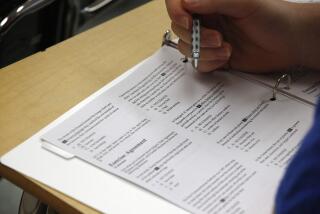Better schools through smarter testing
Despite the barrage of criticism that schools are spending increasing amounts of time testing our children and teachers are being forced to teach to the test, the reality is that testing is no fad. Initiatives like California’s STAR test, the high school exit exam and Academic Performance Index, or API, scores are here to stay, and are likely to become even more pervasive in schools nationwide. But in the years ahead the way testing happens must change in a manner that will benefit our children and that parents are likely to embrace.
The increasing emphasis on testing in U.S. schools is a consequence of perhaps the most profound change in American education in modern times — the shift in focus from teaching to learning. When education systems concentrate on teaching, the emphasis is on the process of instruction, measured in the length of time students are exposed to teaching. (Think, for instance, of the 180-day school year.) Time is the constant; all students are expected to learn the same amount of information in the same period of time.
In contrast, when the focus is on learning, the emphasis shifts to how much the student has mastered rather than how long the student has been taught. There is a shift in concern from the process of education to the outcomes of education, from coverage of a subject to learning the subject matter. Time becomes variable; learning is the constant.
This shift has required states to determine what they want students to learn, then establish standards or outcomes, specifying what students must know and be able to do to earn a diploma. To determine whether students are indeed achieving those outcomes, the states needed tests.
Whether one is a proponent or a critic of this system — and I am a proponent — it is fundamentally flawed. The tests are given too late, after students have completed their studies. In California, for example, standardized tests are given about 85% of the way through the school year. We are testing students to find out whether they have learned the material. If they have, they go forward. If not, they repeat it.
Imagine if your car GPS worked this way — that it let you know how your trip was going, say, only once an hour. Every 60 minutes, it would evaluate your performance, telling you whether you were on course. The GPS might report something like, “This vehicle is off course by 80 miles and driving in the wrong direction,” followed by the dreaded word “recalculating.”
This scenario seems absurd because we have gotten used to having our actions assessed continuously by our GPS, so that we don’t go off course. Its purpose is to enable us to complete a trip successfully, not assess us after the fact on the degree to which we succeeded.
Most of the tests we give children today are like getting a GPS report hourly. However, in the years ahead, testing must become more like our car GPS. The technology exists to make this possible.
Consider the electronic textbooks being developed, with some already in use in a few classrooms. Using the same text, two students study division by fractions. One zooms through the subject, as demonstrated by practice problems, and moves on to the next unit. The same practice problems show that the other student does not understand the material. As with our GPS, the textbook analyzes the student’s errors and “recalculates,” providing additional lessons that focus on what he or she hasn’t understood. This process goes on until the student has learned the material.
This is not to say all learning will be computer-based. Teachers and students can engage in the same process, especially as teachers develop the skills to analyze why a student got the wrong answer and what strategies will lead to a better one.
The point is this: We need to redesign testing so that it becomes integral to the subjects students are studying, rather than an add-on afterward. Tests should gauge what students are learning in real time and continually recalculate the instruction each student needs to learn it. Testing should be the tool to ensure that all students learn, rather the means of catching those who haven’t learned. It can then be a student-and-parents support system.
The challenge we face today is that the heated national debate on testing is focused largely on what we are doing now. It is time to recalculate and shift our efforts to creating the GPS approach that our children need — as quickly as possible.
Arthur Levine, president emeritus of Teachers College, Columbia University, is president of the Woodrow Wilson National Fellowship Foundation.
More to Read
A cure for the common opinion
Get thought-provoking perspectives with our weekly newsletter.
You may occasionally receive promotional content from the Los Angeles Times.





